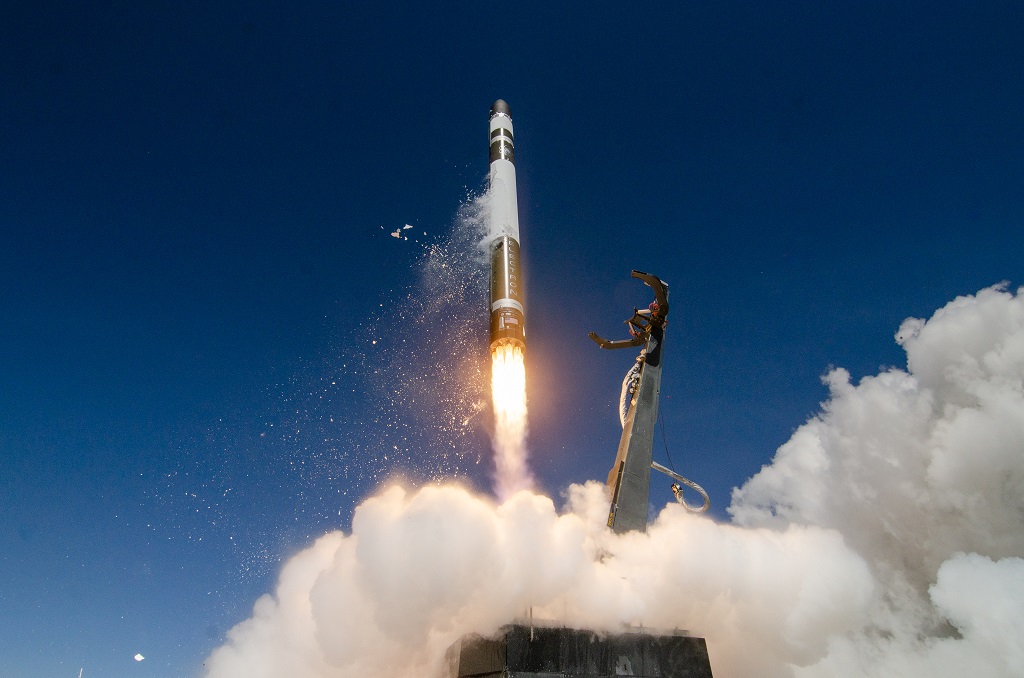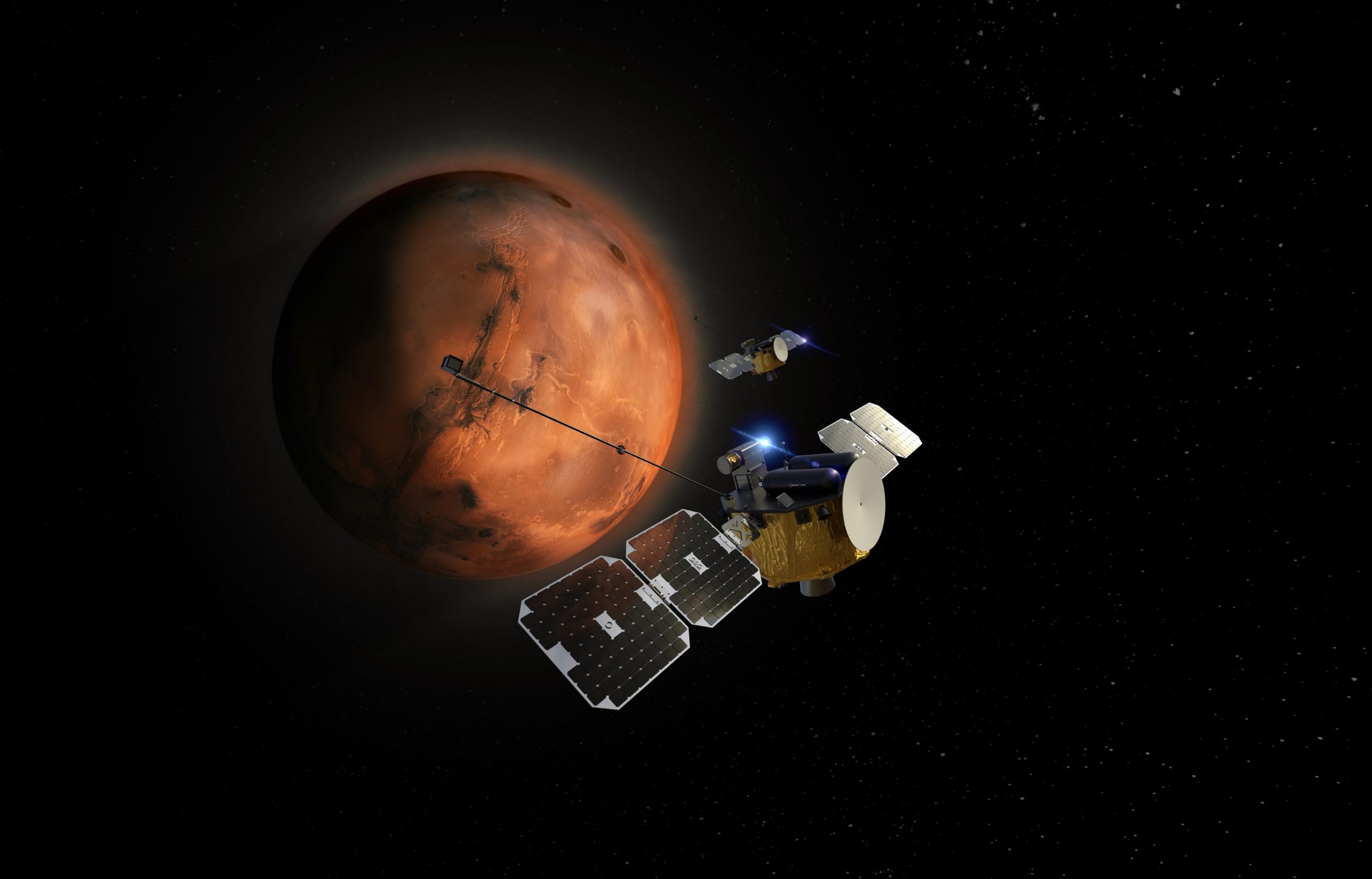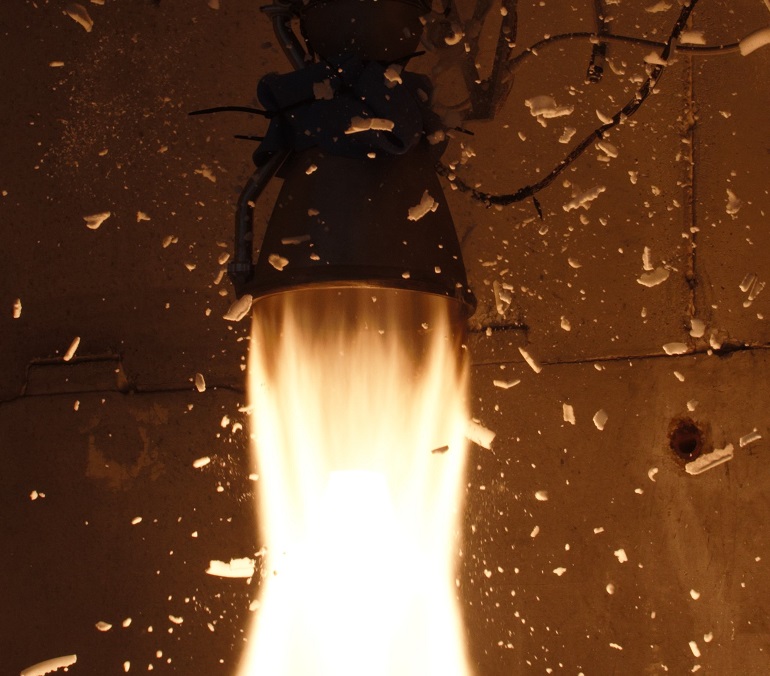“Space is open for business,” said Peter Beck, CEO and Founder of next-generation launcher manufacturer Rocket Lab during the company’s debut on the Nasdaq. In honor of the occasion, the soon-to-be-billionaire rang the market opening bell from Rocket Lab’s headquarters and manufacturing facility in Long Beach, California, in a virtual event.
Trading for the first time under the ticker symbol “RKLB,” the leading space systems company hit the public market as it hopes to take the next step towards unlocking the future potential of space exploration by providing end-to-end mission services, including complete satellite build and launch solutions, for rapid, frequent and reliable access to space.

Rocket Lab CEO Peter Beck displayed on Nasdaq’s LED screen at Times Square, New York, on August 25, 2021, as the company goes public. Image courtesy of Nasdaq via Twitter.
The company, which announced plans to go public back in March 2021, confirmed the closing of its merger deal with Vector Acquisition Corporation, a publicly-traded special purpose acquisition company (SPAC) led by veteran technology investor Alex Slusky, early morning on August 25, 2021. Just a few hours later, Rocket Lab shares opened at $11.58 in the company’s debut, valuing Rocket Lab at roughly $5 billion. However, after dropping nearly 10% and closing the trading session at $10.43, market capitalization was $4.76 billion.
The business merger deal was finally approved during an annual meeting of Vector shareholders on August 20, 2021. Later, Rocket Lab revealed that the closing of its common stock PIPE (short for private investment in public equity) of roughly $777 million would be destined towards the acceleration of organic and inorganic growth in Rocket Lab’s space systems business, as well as helping drive the development of its reusable eight-ton payload class Neutron rocket, and support potential future expansion into space applications enabling data delivery and services from space.

Rocket Lab’s Electron launch system with 3D printed Rutherford engines takes off. Image courtesy of Rocket Lab.
Targeting space exploration, Beck took his childhood vision of conquering space and turned it into a commercially viable, 500-employee rocket company in just over a decade. Since its foundation in 2006, Rocket Lab became a multinational company with a rich history of developing propulsion systems and launching vehicles for many government and commercial customers.
The New Zealand-born engineer said Rocket Lab spacecraft has “simplified space,” making it easy and affordable for companies, scientists, governments, and entrepreneurs alike to get their ideas to orbit.
After becoming the first private company to reach space from the Southern Hemisphere, Rocket Lab has gone on to deliver over 105 satellites to orbit for more than 20 public- and private-sector organizations and completed 21 missions for a wide range of customers, including government agencies like NASA and Defense Advanced Research Projects Agency (DARPA), branches of the military like the U.S. Air Force, and commercial businesses, such as Capella Space.
Although 3D printing is currently regarded as one of the go-to technologies for rocket engine production, Rocket Lab was the first small launcher developer to heavily rely on 3D printing for parts. In 2015, Beck revealed Rutherford, the world’s first oxygen/hydrocarbon electric-pump-fed rocket engine to use 3D printing for all of its primary components, including everything from its injector pumps to its main propellant valves and the regeneratively cooled thrust chamber.
As the second most frequently launched U.S. rocket annually, the company’s flagship two-stage Electron orbital launch vehicle is powered by the in-house designed and produced additively manufactured Rutherford engines. The first and second stage engines are identical, except for a larger expansion ratio nozzle for stage two for improved performance in near-vacuum conditions. Since its first launch in 2017, Rocket Lab has released additional performance from its Rutherford engines boosting the Electron’s total payload lift capacity to 300 kg (660 pounds).
Focused on its mission to develop spacecraft to satisfy all earthly demands in orbit, in late 2020, Rocket Lab tested its novel space tug called Kick Stage. Designed to deliver small satellites to precise and unique orbits, whether flying as dedicated or rideshare on Electron or another vehicle, the Kick Stage’s in-space transportation capabilities, which span deploying satellites to precise orbits as well as orbit raising or lowering, inclination changes, and de-orbit capability is a streamlined path to space.

Rocket Lab’s Kick Stage space tug with the four silver spheres of the new Curie 3D printed engine seen in the middle. Image courtesy of Rocket Lab.
The Kick Stage’s propulsion system consists of Rocket Lab’s in-house designed and built 3D printed Curie engine. With flight heritage across more than a dozen orbital missions, the pressure-fed engine is a storable, re-startable, bi-propellant liquid propellant engine integrated with lightweight composite propellant tanks and valves into a single compact module.
Headquartered in California, Rocket Lab operates launch sites in Māhia, New Zealand, and Wallops Island, Virginia. It has more than five acres of manufacturing facilities and test complexes and employs advanced manufacturing techniques, including 3D printing, to enable high-rate production of satellites and launch vehicles.

Rocket Lab will develop twin Photons to orbit Mars for NASA’s ESCAPADE mission spacecraft. Image courtesy of NASA.
Aside from designing and manufacturing the Electron launch vehicles and Kick Stage space tug, the company created the Photon satellite platform for delivering a satellite-as-a-service solution that eliminates the typical high cost, time, and complexity customers face when building their own satellites. Rocket Lab offers the whole packaged deal to customers as a turn-key solution so that they can buy launch, satellite, ground services, and on-orbit management all at once.
There are currently two operational Photons in orbit, with additional missions to the Moon, Mars and Venus planned, including the Cislunar Autonomous Positioning System Technology Operations and Navigation Experiment (CAPSTONE) mission to lunar orbit in support of NASA’s Artemis program. As well as providing the Photon program for NASA’s space operations in the recently approved Escape and Plasma Acceleration and Dynamics Explorers (ESCAPADE) mission to Mars.
Subscribe to Our Email Newsletter
Stay up-to-date on all the latest news from the 3D printing industry and receive information and offers from third party vendors.
Print Services
Upload your 3D Models and get them printed quickly and efficiently.
You May Also Like
3D Printing News Briefs, June 11, 2025: Sustainability, Automotive Tooling, & More
We’re starting with sustainability news in today’s 3D Printing News Briefs, as EOS has strengthened its commitment on climate responsibility, and Zestep is making 3D printing filament out of eyewear...
3D Printing 50 Polymer Stand-In Parts for Tokamaks at the PPPL & Elytt Energy
Of all the world’s things, a tokamak is one of the hardest, most complex, expensive and exacting ones to make. These fusion energy devices make plasma, and use magnets to...
3D Printing News Briefs, May 17, 2025: Color-Changing Materials, Humanoid Robot, & More
We’re covering research innovations in today’s 3D Printing News Briefs! First, Penn Engineering developed 3D printed materials that change color under stress, and UC Berkeley researchers created an open source,...
Firehawk Aerospace Partners with JuggerBot 3D, Gets $1.25M from AFWERX for 3D Printed Propellants
Texas-based Firehawk Aerospace, an advanced energetic materials firm that works with aerospace and defense applications, announced a strategic partnership with JuggerBot 3D, an Ohio-based large-format 3D printer manufacturer. Together, the...


































